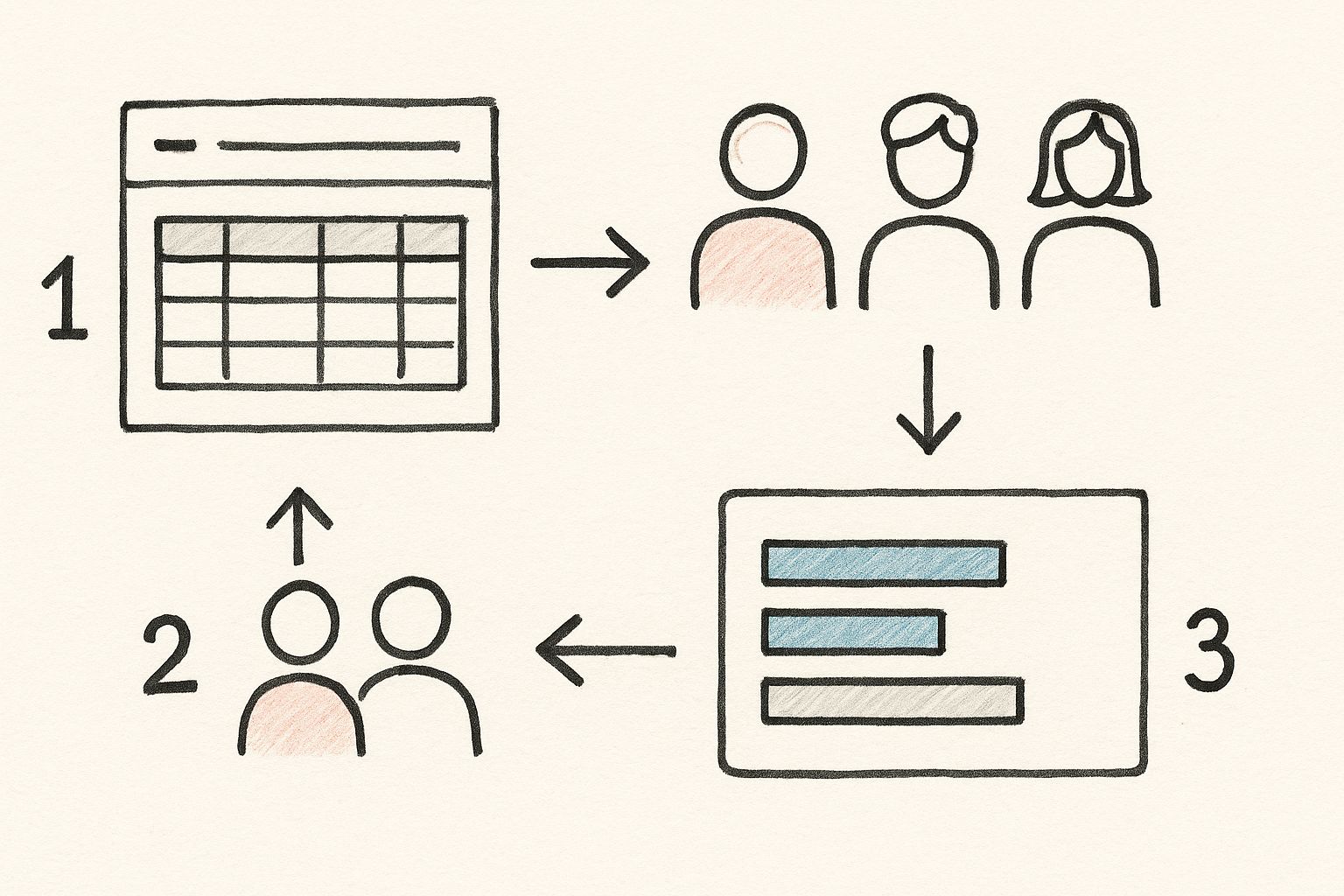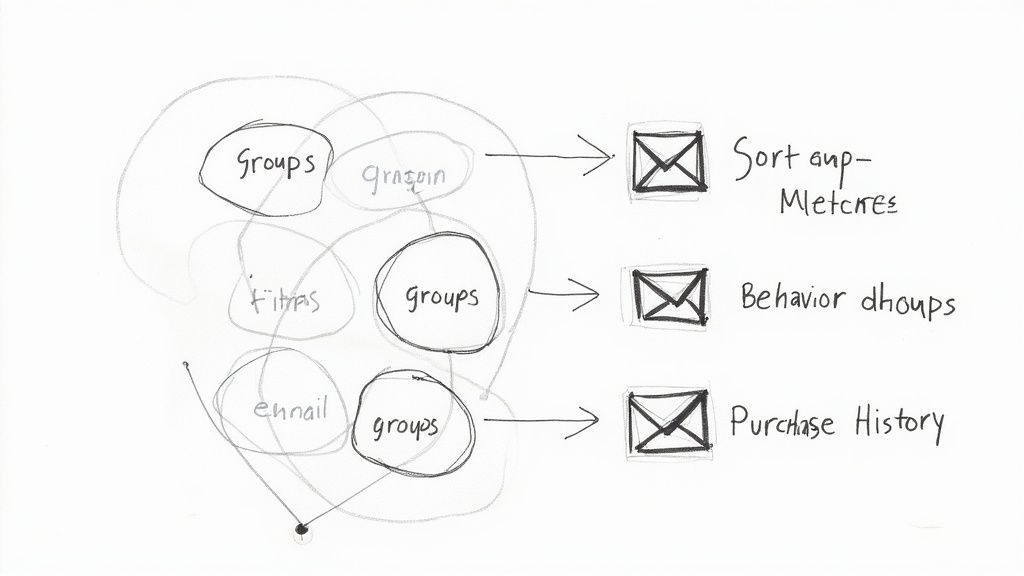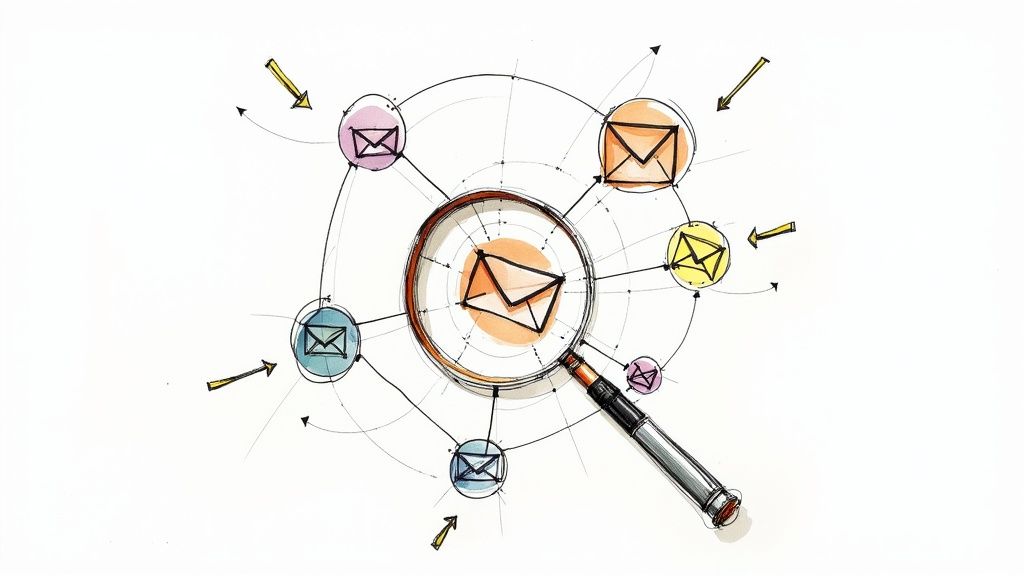To segment your email list effectively, you really just need to start grouping subscribers based on simple things like their signup date, what they've bought, or how often they open your emails. It's about shifting away from those generic, one-size-fits-all messages and creating smaller, targeted lists so you can send content that actually matters to them.
Why Generic Email Blasts Fail Modern Audiences
Think about the last email you got that felt like it was written just for you. It probably made you pause, right? Now, compare that to the dozens of generic promos you trash every day without a second thought. The difference is crystal clear: relevance.
The days of shouting the same message at your entire list are long gone. Today's subscribers are drowning in digital noise and they expect more. A generic email sent to thousands of people—all with different interests, needs, and histories—is like putting up a billboard on a packed highway. Most people just drive right by.
This "spray and pray" approach doesn't just lead to dismal engagement. It can actually hurt your brand, causing more people to unsubscribe and, even worse, flagging your messages as spam.
The Power of Speaking Directly to Subscribers
Great email marketing feels like a conversation, not a megaphone. To have a real conversation, you first need to know who you're talking to.
Imagine you run an online store that sells both high-end hiking gear and yoga apparel. Sending a "20% Off All Hiking Boots" email to a customer who has only ever bought yoga mats isn't just a missed opportunity. It screams, "We don't know you, and we don't care to."
This is exactly where knowing how to segment your email list becomes a total game-changer.
By creating distinct groups, you can tailor your message with surgical precision. The hiker gets the boot sale alert, while the yoga lover gets a heads-up about new eco-friendly mats. This targeted approach shows you're paying attention and you respect their interests.
Before we dive deeper, let's look at how much of a difference this can make.
Segmentation Impact at a Glance
This table offers a quick snapshot of how segmented campaigns typically stack up against their generic counterparts. The numbers speak for themselves.
The contrast is stark. Segmented campaigns consistently outperform generic ones across every important metric, leading to better engagement and a healthier bottom line.
The impact of this strategy is backed by hard data. Segmented email campaigns can achieve up to 30% higher open rates and 50% higher click-through rates than non-segmented ones. Personalized subject lines alone can boost opens by another 50%, showing just how much subscribers value content that feels made for them.
Ultimately, segmentation turns your email marketing from a blunt instrument into a precision tool. It ensures your messages land with impact, which is essential for maintaining excellent email deliverability best practices and protecting your sender reputation. By ditching the generic blasts, you'll build loyalty, drive more conversions, and foster a genuinely meaningful relationship with every single person on your list.
The Four Core Methods of Email Segmentation
To really get good at segmenting email lists, you need a solid framework. Trying to create segments on the fly is like building a house without a blueprint—it gets messy, and the foundation will be weak. The good news is that pretty much any effective segmentation strategy boils down to four core methods.
These four pillars give you a clear, structured way to slice and dice your audience. The goal isn't just to divide your list; it's to understand why you're dividing it. Once you get these down, you'll stop sending generic blasts and start having meaningful, personalized conversations.
Demographic Segmentation: Who They Are
This is the most common starting point, and for good reason—it’s often the easiest data to get. Demographic segmentation is all about grouping your subscribers based on objective, statistical attributes. Think of it as the "who" of your audience—their basic personal details.
For an e-commerce brand selling skincare, this could mean segmenting by age group. A 22-year-old’s skin concerns are a world away from a 55-year-old’s. One person might get emails about acne solutions, while the other sees content about anti-aging serums.
This data is just as crucial in the B2B world. A software company might segment its list by job title or company size. An email highlighting cost-saving features would hit the inbox of startup founders, while a message focused on enterprise-level security and scalability would go straight to CTOs at larger corporations.
So, how do you get this info?
- Signup Forms: Don't be shy. Ask for key details like age, industry, or job role right when they subscribe.
- Surveys: Send occasional surveys to your list to build out richer customer profiles. People are often happy to share if it means getting more relevant content.
- Third-Party Data: For more advanced setups, data enrichment tools can append this information to your existing contacts.
This visual shows how you can layer different data points, like demographics and engagement, to build out much smarter segments.
As you can see, the real power comes from combining simple profile details with how users actually interact with your brand.
Geographic Segmentation: Where They Are
Next up is location. Geographic segmentation groups subscribers based on where they live or work, from their country and city right down to a specific zip code. This is a game-changer for any business with a physical footprint or location-dependent offers.
A national restaurant chain, for instance, would be foolish not to use geographic segments. They can send promotions that are only valid at local branches. Sending a "Free Appetizer in Austin" coupon to someone in Boston is a fast way to get an unsubscribe.
A concert promoter would do the same, targeting subscribers based on their proximity to a venue. It's all about delivering content that's not just relevant, but geographically actionable. And don't dismiss this if you're a purely online business. You can still use it to build campaigns around regional holidays, weather patterns, or local cultural trends.
Psychographic Segmentation: Why They Care
Okay, this is where things get really interesting. Psychographic segmentation goes beyond the "who" and "where" to dig into the "why." It groups people based on their lifestyles, interests, personal values, and core beliefs. It’s all about understanding what makes your audience tick.
Imagine a sustainable fashion brand. They could create a segment for "Eco-Conscious Consumers." This group wouldn't just get blasted with product promotions. Instead, they’d receive emails about the brand’s ethical sourcing, the low environmental impact of their materials, and stories about the artisans who make the clothes. This type of content connects with their values, building a much deeper brand loyalty.
Another great example is a fitness app. They might have segments for "Casual Exercisers" and "Marathon Trainers." The casual group gets quick 15-minute workout ideas, while the marathoners receive advanced training plans and nutrition tips for endurance athletes.
Key Takeaway: Psychographics help you connect with subscribers on a shared-values level, which is far more powerful than a simple transactional relationship.
Behavioral Segmentation: What They Do
Finally, we get to what I consider the most powerful method for actually driving sales: behavioral segmentation. This strategy groups subscribers based on their direct interactions with your brand—their actions, or even their inactions.
This is where the magic happens because you're reacting to real-time signals they're sending you. Some of the most common and effective behavioral segments include:
- Purchase History: Grouping customers by what they've bought, how much they've spent, or how often they buy. A customer who just bought a camera is the perfect person to receive an email about lenses and accessories.
- Email Engagement: This is a big one. You can create segments for your super-fans (e.g., opened the last 5 emails) or run re-engagement campaigns for those who haven't opened an email in 90 days.
- Website Activity: Tracking users who looked at a specific product page but didn't buy is gold. And, of course, the classic abandoned cart segment. These allow for incredibly timely and targeted follow-ups that can recover a ton of lost revenue.
At the end of the day, these four methods aren't meant to be used in isolation. They are building blocks. The most sophisticated email marketers layer them to create laser-focused audience groups. You can learn more about how these four segmentation types work together on Moosend to build a killer strategy. The best approach almost always combines demographic data with behavioral triggers for maximum impact.
Building Your First High-Impact Segments

Okay, theory is great, but putting it into practice is where you see the real wins. To get good at segmenting an email list, you have to get your hands dirty and actually build a few. This is where you start turning raw data into real conversations that build relationships and, ultimately, drive sales.
Let's walk through creating three of the most effective segments you can set up right now. These are incredibly powerful because they target critical moments in the customer journey—from that first "hello" to rewarding your best customers and even winning back those who've gone quiet.
The Welcoming Committee: Your New Subscribers
First impressions matter. A lot. When someone gives you their email address, you've got a short, crucial window to make them feel welcome, smart for signing up, and genuinely excited to hear from you. That's the whole job of your "New Subscriber" segment.
The goal here is simple: nurture these fresh leads and guide them toward their first meaningful action with your brand.
The Criteria
The rule for this one is pretty straightforward. You're looking for anyone who just joined your list but hasn't opened their wallet yet.
- Condition 1:
Subscription Dateis within the last 14-30 days. - Condition 2:
Total Ordersis equal to 0.
Most modern email platforms let you build dynamic segments that handle this automatically. New people get added, and as soon as they buy something, they're moved out. Set it and forget it.
Content Strategy
Your tone should be warm and educational, not salesy. You're building trust, not pushing for a quick buck.
- Email 1 (Day 1): A warm welcome that confirms their subscription and reminds them of your brand's core promise. Keep it simple.
- Email 2 (Day 3): Tell your story. What’s your mission? What makes you different from everyone else?
- Email 3 (Day 7): Show off your greatest hits. Point them to your most popular products or best-performing blog posts. It helps them discover what you're all about without feeling pressured.
- Email 4 (Day 12): Time for a gentle nudge. A small, one-time offer like 10% off their first purchase can be the perfect little push to get them over the line.
By creating a dedicated onboarding flow, you’re not just sending emails—you’re starting a relationship off on the right foot. This early engagement is a massive factor in long-term customer retention.
Rewarding Your VIPs
Your best customers are your biggest asset. They buy more often, spend more money, and are the most likely people to tell their friends about you. A "VIP Customer" segment is how you show them you know they're special. This is how you turn repeat buyers into lifelong fans.
Your goal is to boost loyalty and crank up that customer lifetime value.
The Criteria
What makes a VIP? It can vary, but it usually comes down to how often they buy, how much they spend, or a mix of both.
- Option A (Frequency):
Total Ordersis greater than 3. - Option B (Monetary):
Total Revenueis greater than $500. - Option C (Combined): They meet both of the above criteria. This is your super-exclusive, inner-circle group.
Here's a peek at what layering conditions might look like inside an email marketing tool.

As you can see, you can stack different rules—like purchase history and specific product interests—to create a laser-focused (and very valuable) segment.
Content Strategy
Your VIPs should never get the same generic promos as everyone else. Make them feel like insiders.
- Exclusive Access: Let them buy new products before anyone else.
- Special Offers: Send them bigger discounts or unique product bundles that no one else sees.
- Feedback Requests: Ask for their opinion on new product ideas. It shows you value their expertise and gives you priceless market research.
- Loyalty Rewards: Surprise them with a small gift or a simple "thank you" email out of the blue.
Winning Back Your Inactive Subscribers
Look, it happens. Not everyone who signs up stays engaged. Life gets busy, priorities shift, or they just plain forget about you. An "Inactive Subscriber" or "Win-Back" segment is your shot at reigniting that spark before they unsubscribe for good.
The goal is twofold: re-engage people who've tuned out and, just as importantly, clean your list of contacts who are truly gone. This is one of the best ways to reduce your email unsubscribe rate and keep your list healthy.
The Criteria
Inactivity is usually measured by a lack of opens or clicks over a certain time. It’s also smart to exclude recent buyers, since they're clearly still engaged with your brand, even if they aren't opening emails.
- Condition 1:
Last Opened Emailwas more than 90 days ago. - Condition 2:
Last Clicked Emailwas more than 90 days ago. - Condition 3:
Last Order Datewas more than 120 days ago.
Content Strategy
Your approach here has to be direct and compelling. You need to give them a really good reason to pay attention again.
- The Gentle Nudge: Start with a subject line like, "Is This Goodbye?" or "We Miss You." Remind them why they signed up in the first place.
- The Irresistible Offer: If that doesn't work, hit them with your best offer. A steep discount—think 25% off or more—is hard to ignore and can snap them back to attention.
- The Last Call: Be straight with them. Let them know you'll be removing them from your active list if they don't re-engage. It often prompts a click, and if it doesn't, you're respecting their inbox by letting them go.
By building out these three core segments, you're laying a powerful foundation for a more relevant, personal, and effective email strategy. They're a fantastic starting point that will immediately level up the connection you have with every single person on your list.
Advanced Segmentation Strategies to Maximize ROI
Alright, so you’ve got the basics down. You’re no longer blasting your entire list with the same message, and that's a huge win. But if you really want to see your ROI explode, it's time to move beyond foundational segments. This is where you graduate from reacting to customer behavior to actively predicting it.
Think of it this way: basic segmentation is about looking at what people have done. Advanced segmentation is about weaving together multiple data points to understand what they're likely to do next. This is how you create those "wow, they really get me" moments for your subscribers.
Dive Deep with RFM Analysis
One of the most powerful, time-tested methods for identifying your best customers is RFM analysis. It stands for Recency, Frequency, and Monetary. Instead of just looking at one piece of the puzzle, RFM combines three critical data points to score and rank your customers.
- Recency: How recently did they buy? A customer who purchased last week is infinitely more engaged than one whose last order was a year ago.
- Frequency: How often do they come back? Someone with ten orders is a much better bet than a one-time buyer.
- Monetary: How much have they spent? Your big spenders are an obvious group you need to treat like gold.
The magic happens when you score each customer on these three metrics (say, on a scale of 1-5). This lets you create incredibly granular segments. For instance, a customer who scores high on all three is a "Champion"—your VIP. Someone with low scores across the board might be at risk of churning, making them a perfect candidate for a win-back campaign.
With RFM, you get a clear roadmap. You can spot your "Loyal Customers" (high frequency, maybe lower monetary value) and send them exclusive offers to try out your premium products.
Predict the Future with Predictive Segmentation
What if you could target customers based on what they're going to do? That’s not science fiction; it's predictive segmentation. Using historical data and machine learning, you can forecast future behaviors like a customer's likelihood to churn, their potential lifetime value, or their odds of making another purchase.
And no, this isn't just for Fortune 500 companies anymore. Many modern email platforms are building these tools right in.
Imagine automatically flagging customers who are at high risk of going dormant before they actually stop opening your emails. You could step in with a targeted survey or a special offer, stopping churn in its tracks.
This proactive approach is a total game-changer. Instead of waiting for a subscriber to be inactive for 90 days to trigger a generic win-back email, you can intervene at day 30 with a personalized message because the data signals they're losing interest.
Master the Journey with Lifecycle Stage Segmentation
Every subscriber is on a different path with your brand. Speaking to them based on where they are in that journey is one of the most effective ways to build a real relationship. Lifecycle stage segmentation moves beyond a simple "new subscriber" bucket to map out the entire customer path.
It’s about understanding the nuances between different types of subscribers and tailoring your communication accordingly.
Basic vs. Advanced Segmentation Techniques
To really grasp the power of this, let's compare some basic segments with their more advanced, strategic counterparts. You'll quickly see how a simple shift in perspective can open up a world of opportunity.
As you can see, the more sophisticated the technique, the more targeted your goal becomes—and the higher the potential return. Each advanced method builds on the last, giving you a clearer picture of your audience.
Each of these lifecycle stages demands a completely different conversation. You wouldn't push a referral program on a brand-new lead, but it’s the perfect ask for a loyal brand advocate. Getting this timing right ensures your message always lands perfectly.
The payoff for this level of detail is staggering. Marketers who use advanced segmentation have seen as much as a 760% increase in revenue. When you consider that the average return for email can be up to $42 for every $1 spent, these advanced tactics are how you hit those top-tier numbers. You can dig into more of these powerful email marketing ROI statistics on Inboxally.
Ultimately, these strategies help create a dynamic, responsive system. You can even combine them—for example, using predictive analytics to find high-potential leads within your "New Customer" lifecycle stage. This is a foundational piece of a smart, automated email marketing system that boosts conversions without you having to pull the levers every single day. By going beyond the basics, you're no longer just sending emails; you're orchestrating personalized experiences that drive serious growth.
Getting a solid segmentation strategy in place is a huge win. But even the best plans can get derailed by a few common slip-ups. Knowing how to segment is only half the battle—the other half is sidestepping the pitfalls that waste your time and tank your results.
Let's walk through the most frequent mistakes I see people make and, more importantly, how you can steer clear of them.
Over-Segmenting Your List
It’s tempting to get a little carried away once you see what segmentation can do. You start creating groups for every tiny behavioral quirk until you’re staring at dozens of micro-segments, each with just a handful of subscribers. This is a classic case of too much of a good thing.
When a segment gets too small, you lose all statistical significance. It's impossible to tell if your A/B tests are actually working or if the results are just a random fluke. Plus, trying to create and manage custom content for 25 different segments is a logistical nightmare that leads straight to burnout with very little to show for it.
Pro Tip: Your goal should be segments that are big enough to give you solid data but still specific enough to be relevant. If you have a segment with fewer than 50-100 subscribers, think about whether you can merge it with a similar group without losing the strategic reason it exists in the first place.
Relying on Stale or Outdated Data
Your subscribers aren't frozen in time. They change jobs, move to new cities, and their interests evolve. A segment you built on data from two years ago? It's pretty much useless today. Sending a location-based offer to someone who moved last year doesn't just fall flat—it makes your brand look disconnected.
Stale data is the number one cause of bad personalization, which drags down your engagement rates. If you see your opens and clicks taking a nosedive, outdated segments are often the culprit. This doesn't just hurt conversions; it can slowly chip away at your sender reputation.
To fight this, you need to be proactive about keeping your data fresh.
- Clean your list regularly. Every three to six months, do a sweep to remove invalid or bouncing email addresses. It's just good hygiene.
- Ask for updates. A simple campaign asking subscribers to update their preferences can work wonders. Frame it as, "Help us send you more of what you love."
- Focus on behavioral data. Prioritize dynamic segments based on recent actions (like purchase activity) over static demographics. They update in real time and are far more powerful.
A clean, accurate list is the foundation of good deliverability. It's a key part of learning how to avoid spam filters and reach the inbox, because mailbox providers reward senders who have low bounce rates and high engagement.
Forgetting to Test and Refine
The single biggest mistake is treating segmentation as a "set it and forget it" project. What worked brilliantly last quarter might completely flop next quarter. Customer behavior is always shifting, new trends emerge, and your initial assumptions might have been off from the start.
Without consistent testing, you're just guessing. You have no real proof that your strategy is effective or if you’re just sending different emails to different people with zero impact on your bottom line.
Here’s an actionable plan to get you started:
- Test your segment theories. Start with a hypothesis. For example, "Subscribers who bought Product X will convert better on an upsell offer for a related accessory than on a general 10% discount." Then, build a test to prove or disprove it.
- A/B test your content within segments. Pick a segment and test different subject lines, offers, and calls-to-action to see what that specific group responds to.
- Analyze and iterate. Dig into your campaign reports. Did your "VIP" segment actually deliver a higher conversion rate? Did that win-back campaign bring anyone back from the dead? Use what you learn to fine-tune your criteria and messaging for the next send.
Your Email Segmentation Questions Answered

Even with the best plan, jumping into email segmentation for the first time can feel a little confusing. It’s totally normal to have questions pop up as you go.
Let’s tackle some of the most common ones we hear from marketers. Getting these cleared up will help you build a strategy that actually works, right from the start.
How Many Segments Should I Start With?
This is the big one, and the answer is simpler than you think: there's no magic number. A huge mistake I see people make is trying to create dozens of segments from day one. That’s a fast track to getting overwhelmed.
Instead, start with 3-5 high-impact groups that line up with your biggest business goals.
Here are a few solid starting points:
- New Subscribers: These folks need a proper welcome and nurturing.
- Active Customers: Anyone who bought something recently.
- VIPs or Repeat Buyers: Your most loyal fans who deserve some extra love.
- Inactive Subscribers: The perfect group for a targeted win-back campaign.
The goal isn't to have the most segments; it's to have the most meaningful ones. Each group should be different enough to need its own messaging and big enough to give you real data.
What Tools Do I Need for Email Segmentation?
You probably already have everything you need. Seriously. Most modern email service providers (ESPs) like Mailchimp, ActiveCampaign, or Klaviyo have powerful segmentation tools built right in.
These platforms let you create rules based on all sorts of data:
- Subscriber info (like signup date or location)
- Custom tags and fields you create
- Behavioral data (email opens, clicks, purchase history)
For most businesses, your ESP is more than capable. You’d only need to think about a dedicated Customer Data Platform (CDP) if you're wrangling extremely complex data from dozens of different sources across a large company.
Your ESP is the engine for segmentation. The real work isn't finding a new tool, but learning how to max out the features you already pay for.
How Often Should I Update My Segments?
The best segments are the ones you don't have to touch. Your behavioral segments—like "abandoned cart" or "new customer"—should be dynamic. This means they update automatically based on what your subscribers do.
Someone in your "New Subscriber" group should instantly move to "First-Time Customer" the second they buy something. No manual work required.
Beyond that, it’s just good practice to do a full list hygiene review every 3-6 months. This is where you clean out invalid emails and take a hard look at your long-term inactive subscribers. You can decide if you want to try one last win-back campaign or just remove them to protect your sender reputation.
Keeping your data fresh is what keeps your messaging relevant. For those ready to take it a step further, our guide on using AI for email personalization can show you how to make your segments even more intelligent over time.














































.jpeg)


.png)























































